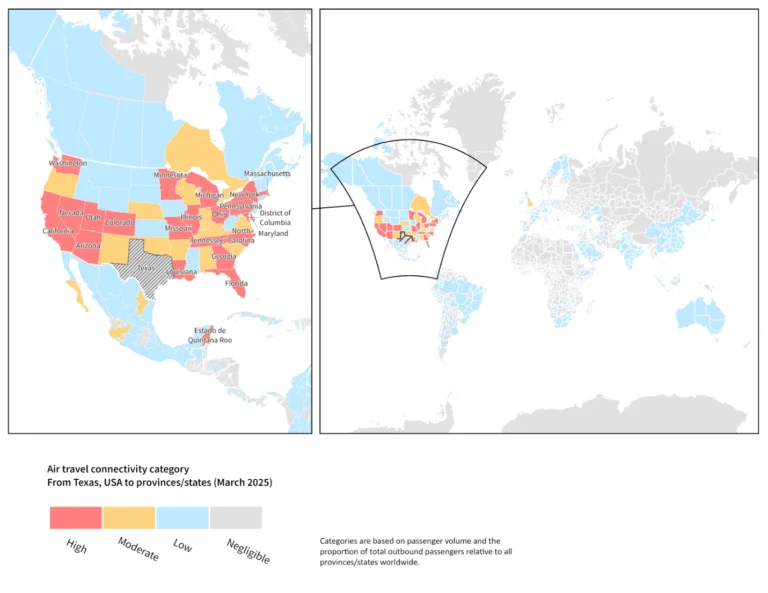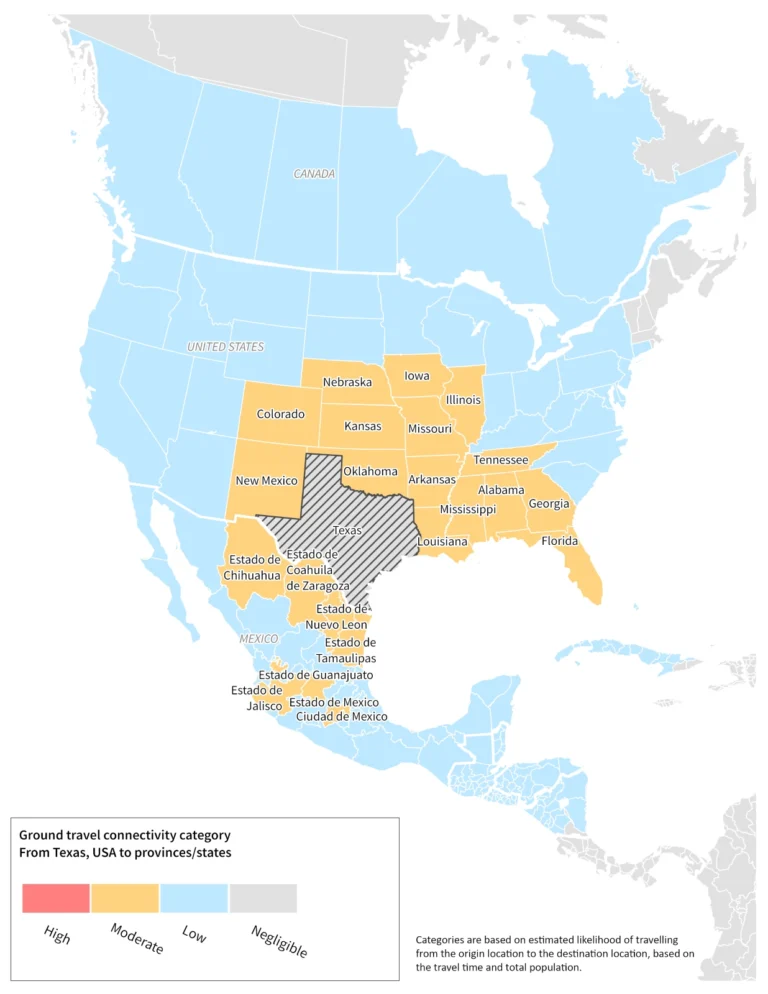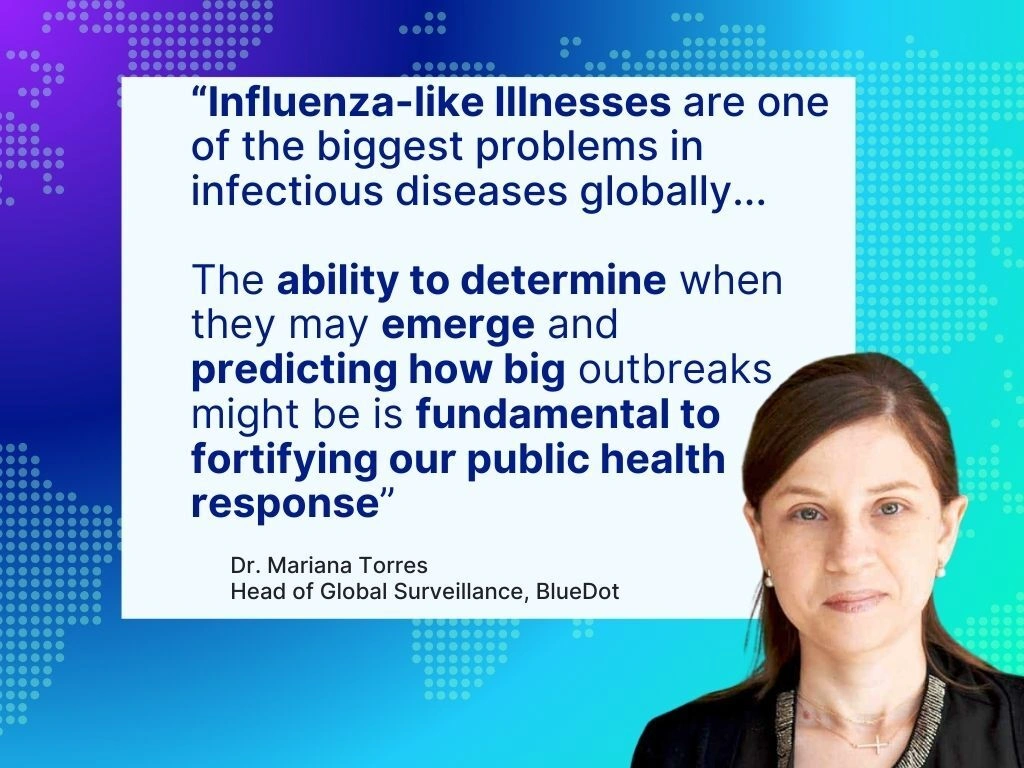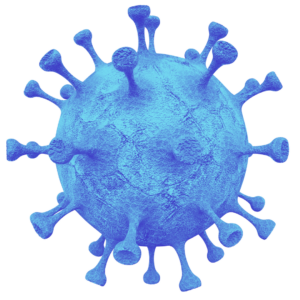Outbreaks across the US and around the globe are intensifying as vaccination rates decline
By the end of last week, measles outbreaks in the United States had led to two deaths and 407 cases since January 1, exceeding 2024’s total cases in just the first 12 weeks of 2025. Most cases are linked to the ongoing outbreak in Texas, including cases in New Mexico and Oklahoma, while around 13% of cases are linked to international travel or smaller outbreaks elsewhere. All told, 19 states have reported cases to date.
Approximately 95% of cases have been among those who are unvaccinated or who have unknown vaccination status, and with vaccination coverage in decline across the US, the Texas outbreak has the potential to spread further afield. In 2023-2024, 92.7% of US kindergartners were vaccinated, down from 95.2% in 2019-2020, lower than the 95% threshold needed to prevent outbreaks. This year marks the 25th anniversary of measles’ official elimination in the US, but as cases rise the nation risks losing that status.
The US isn’t the only country seeing surging measles cases amid declining vaccination rates. Canada, which has seen vaccination rates decline to 82.5%, has reported 369 confirmed cases this year to March 21, mostly in Ontario, approximately 90% of which were among those unvaccinated or with unknown status. Vietnam has reported more than 40,000 cases during the first two months of the year as some areas have less than 50% vaccination coverage. Between August 2024 and January 2025, cases also spiked in Yemen, India, Thailand, and Romania.
Measles outbreaks are ongoing in every region around the globe as countries confront both imported and locally acquired cases of the virus. And confirmed case counts are just the tip of the iceberg. “Measles is a bellwether disease because it’s so transmissible,” says Andrea Thomas, PhD, BlueDot’s head of epidemiology. “We expect to see rising case counts for other vaccine-preventable diseases as well.”
Mapping measles: from identification to infection prevention
First described in the 9th century, measles is a viral respiratory illness that is endemic around the globe. Believed to have evolved from rinderpest, a highly contagious infectious disease primarily affecting cattle and buffalo, measles is one of the most contagious infectious diseases in the world. Transmitted by droplets from an infected person, one person with measles can infect 12-18 others. Prior to the introduction of the vaccine in 1963, major measles epidemics were common, with 30 million cases and 2 million deaths annually around the globe.
Along with the typical rash, patients with measles experience flu-like symptoms, including fever, sore throat, and cough. Symptoms can range from mild to severe, with approximately 40% hospitalized due to illness. In more severe cases, complications can be life-threatening, such as pneumonia, encephalitis, or death. There is no cure for measles once contracted. Further, measles can cause “immune amnesia,” meaning it can destroy immune system memory and increase vulnerability to other infectious diseases.
Two doses of the vaccine confer immunity in greater than 99% of people. Despite international measles immunization programs preventing approximately 60 million deaths between 2000 and 2023, vaccination rates have been declining worldwide. In 2023, 83% of children received their first dose, down from 86% in 2019. In Gaines County, Texas, where the US outbreak began, only 46% of kindergartners in the Loop Independent School District were vaccinated against measles in 2023 compared with 82% in 2019. Disrupted vaccine supply and rollout due to the COVID-19 pandemic, combined with growing vaccine hesitancy and skepticism, present a significant public health challenge in preventing devastating outcomes for those at increased risk, especially young children who are not yet able to be vaccinated.
4 Top Takeaways
- Measles makes a resurgence. Nearly 400 cases and two deaths have been reported in the US following an outbreak that erupted in Texas. Other outbreaks have been reported recently in Canada, Vietnam, and Romania. True case counts are likely higher in some locations given differences in access to testing and similarity to other conditions that can cause overlapping symptoms.
- Measles may be severe or deadly. Measles is associated with severe complications, including pneumonia and encephalitis, especially among those who are not vaccinated or under-vaccinated. To date, the US measles outbreaks have led to more than 60 hospitalizations.
- Low vaccination rates magnify measles transmission. Disrupted vaccine programs during the COVID-19 pandemic and growing vaccine hesitancy are contributing to the current outbreak, including in countries such as the US and Canada where outbreaks are usually rare and cases limited to international travellers.
- Mitigating measles’ cross-border spread. The Texas outbreak has spread to at least two other states and into Mexico, while the global resurgence means that cases will continue to be imported from abroad. National health authorities are working to evaluate and bolster their public health response, including through vaccination campaigns.
Predicting and preventing further measles spread
Given the disease’s high transmissibility, measles outbreaks have rapidly spread. Using a gravity model that accounts for population size and travel time, BlueDot developed a new technique that maps air and ground travel to predict infectious disease spread from outbreak epicenters to other areas nationally and globally. This method led BlueDot to correctly predict the initial spread of measles from Texas to New Mexico, Oklahoma, and across the border into Mexico.
Within the US, there is relatively high connectivity through air travel from Texas to major urban areas, including in New York and California. While these states have high vaccination rates, smaller communities with low vaccination rates are at particularly high risk as the virus continues to spread. This is especially concerning in areas of Central or South America, such as Brazil and Paraguay, which have national vaccination rates of 81% and 54%, respectively; Brazil confirmed two cases in mid-March.
Air Travel Connectivity from Texas, USA (March 2025)

Source: BlueDot, March 2025.
Ground connectivity from Texas is predicted to be moderate in approximately 15 US states, as well as in Mexican states south of the border. Nearly all US states report vaccination rates lower than 95%, raising concerns about transmission in areas with low vaccination rates. Oklahoma and Colorado both have 88.3% vaccine coverage, while Kansas, Missouri, Arkansas, and Louisiana hover between 90-92.5% coverage. So far, approximately 64 people have been hospitalized, more than a quarter of which are children younger than 5 years of age.
Ground Travel Connectivity from Texas, USA

Source: BlueDot, March 2025.
In Mexico, 22 cases had been confirmed and 416 were suspected as of March 18, with more cases anticipated as 2023 vaccination coverage dipped below 80%. While ground travel to Canada is also a low-likelihood scenario, any spread there could exacerbate existing outbreaks, which first emerged last autumn. This year alone, 440 suspected or probable cases have been reported in the province of Ontario, primarily among those who are unimmunized. Although these countries have robust healthcare systems, large outbreaks can still strain the healthcare system and lead to fatalities or detrimental long-term outcomes.
Case counts are likely underreported as people refrain from getting tested, especially among those with milder symptoms. Research estimates that, with a decline in vaccination coverage from 95% to 92%, an additional 6 million American children will be susceptible to measles if vaccination campaigns can’t make up the gap.
Vaccination is the gold standard to prevent measles outbreaks. The vaccine has been available for several decades and is proven to be safe and effective. Since 90% of people who are unvaccinated will contract the virus when in the same room as someone who is infected, it is imperative that vaccination programs rapidly catch up to those who have missed doses.
Measles is an indicator of gaps in immunization coverage and healthcare, so strengthened surveillance and response protocols are needed to prevent widespread transmission of this highly contagious illness — and others.
“The measles outbreaks do not appear to be slowing down anytime soon. If vaccine coverage remains below the 95% threshold, measles will continue to spread,” says Thomas.
On our radar
- USAID in Africa: African nations are at a turning point regarding how to manage funding gaps, especially across health initiatives, following the withdrawal of support from the United States Agency for International Development (USAID). Outbreaks continue unabated, including malaria, mpox, and cholera, and fewer resources are available to provide necessary care. For example, USAID in Ethiopia supported disease surveillance, malaria prevention, and medicine storage, which were critically needed during last year’s malaria outbreak as cases surged past 8 million — the nation’s largest outbreak in seven years. Experts anticipate the funding withdrawal will result in devastating effects and millions of preventable deaths.
- Chikungunya in Réunion and Mauritius: On March 14, health authorities in Réunion, a small island located in the Indian Ocean east of Madagascar, escalated their response to the ongoing chikungunya outbreak as nearly 3,000 cases were reported the week prior. Since January, 8,600 cases have been reported. The outbreak began in August last year following the first locally acquired case in over a decade. Similarly, nearby Mauritius reported their first locally acquired case of chikungunya since 2009 after a first imported case from highly connected Reunion. Both nations have mosquito control protocols underway.
- Marburg in Tanzania: Following a rapid national response, the Ministry of Health in Tanzania declared the end of the Marburg outbreak on March 13, 2025. Declared on January 20, 2025, 10 cases were reported (two confirmed, eight probable) and all
BlueDot will continue to monitor global measles outbreaks closely. To receive global and local outbreak intelligence, sign up here to receive every edition of BlueDot’s biweekly newsletter, Outbreak Insider.









